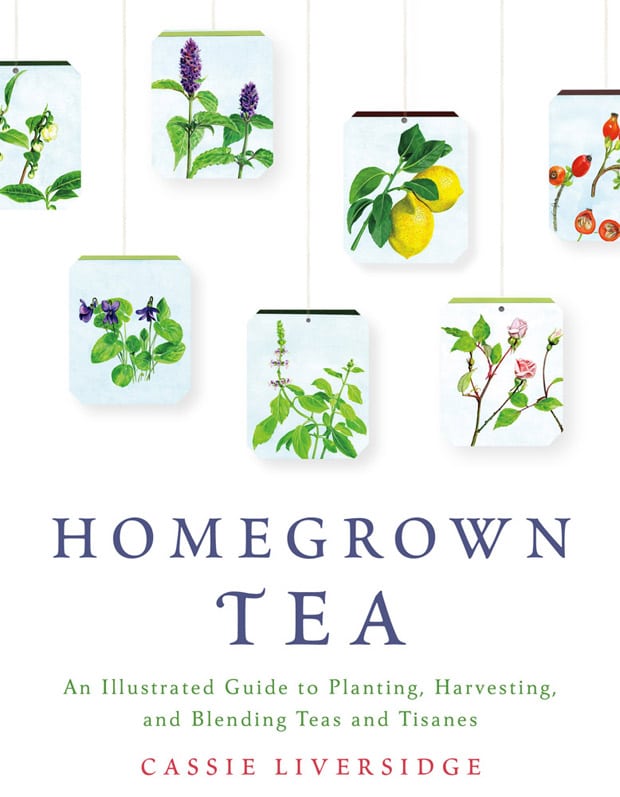 I had an ulterior (well, not that ulterior) motive in picking up this book, and it was mostly just to read the very first section on growing camellia sinensis. To quote the book’s opening paragraph:
I had an ulterior (well, not that ulterior) motive in picking up this book, and it was mostly just to read the very first section on growing camellia sinensis. To quote the book’s opening paragraph:
“Homegrown Tea is a gardening book for tea lovers. It explains how to grow a large variety of plants from which you can make teas and tisanes. Your own garden, balcony, or even windowsill could become your tea cupboard.”
It’s not the first book of it’s kind; I tend to overlook these, but it was shelved beside the World Atlas of Tea, so I flipped through it and realized it had a section on growing and DIY processing of camellia sinensis into a few of the basic types–namely white, green and black, with sidebar Tips on how you’d adapt this for yellow (that surprised me) and oolongs.
It’s not as in-depth and detailed as, say, Tea Growing or Tea Manufacture by Harler, but it’s not meant to be anything more than a fun DIY for the home gardener.
Detailing on how to get started with growing, it has figures on how to grow from cuttings (recommended for tea in general) and how to harvest leaves when the bush is ready. There isn’t any detail on how to grow from seeds, but it’s very tricky to do anyways so that’s not surprising (var. sinensis doesn’t grow well from seeds at all, and var. assamica would be slow growing).
The section on processing details only white, green and black types. The section on green briefly explains the difference between Chinese and Japanese processing, but the DIY itself only detailed the Japanese steaming kill-green process.
The white and black processing sections were similarly short, but there were helpful Tip boxes about how oolong and yellow teas differ, as a sort of jumping-off point for experimentation.
It would be interesting to see a more comprehensive DIY book for home-garden tea processing. I know people try to make their own houjicha and reroast aged oolongs themselves, so why not.
I understand the book probably isn’t meant to be read cover to cover, so the repetition of how certain herbs should be planted/harvested is understandable, but there are some general facts that probably could have been pulled out into the beginning or ending of the book. Especially since in a few entries they’re NOT repeated. Mostly warnings about not plucking existing leaves from pre-bought plants because of sprays the gardeners would have used, and most of the steep instructions probably could have been much better summarized in their individual sections.
I didn’t read the book cover to cover, instead reading the first and last chapters and then only the entries on the plants I thought I’d actually be interested in growing. I live in a temperate region, but I don’t think I have the green thumb for most of the plants; maybe a bunch of different mints, bergamot, and violets. Violets interest me especially, as I do like them as far as a flavour goes; it would be neat to make a tea from, and I wouldn’t mind learning how to candy them.
The book covers just about every main constituent of most tisanes, save rooibos and hibiscus (I suspect because the book is geared towards a temperate climate, rooibos and hibiscus must not grow well); it includes tulsi, for those interested. It’s a bit arbitrarily split up into sections based on what you’re supposed to harvest (the leaf, the flower, the fruit or root…). I say arbitrary because a lot of entries detail harvesting from different areas of the same plant.
The back of the book also includes information on suppliers to buy plants from, which I thought was a great touch (although wouldn’t be as useful out-of-country, and would probably become obsolete in a few years). It’s not a particularly expensive book, so not a bad thing to pick up if you like tea and like gardening.
I plan to keep this book in-mind, as the tea club I frequent also has a small garden plot.




27/04/2017 at 1:01 PM
So when are you going to grow your own tea?
27/04/2017 at 11:46 PM
Probably no time soon; I don’t have a garden plot for one.